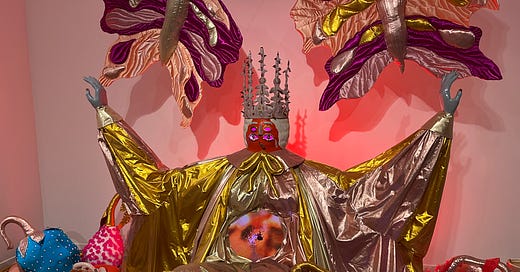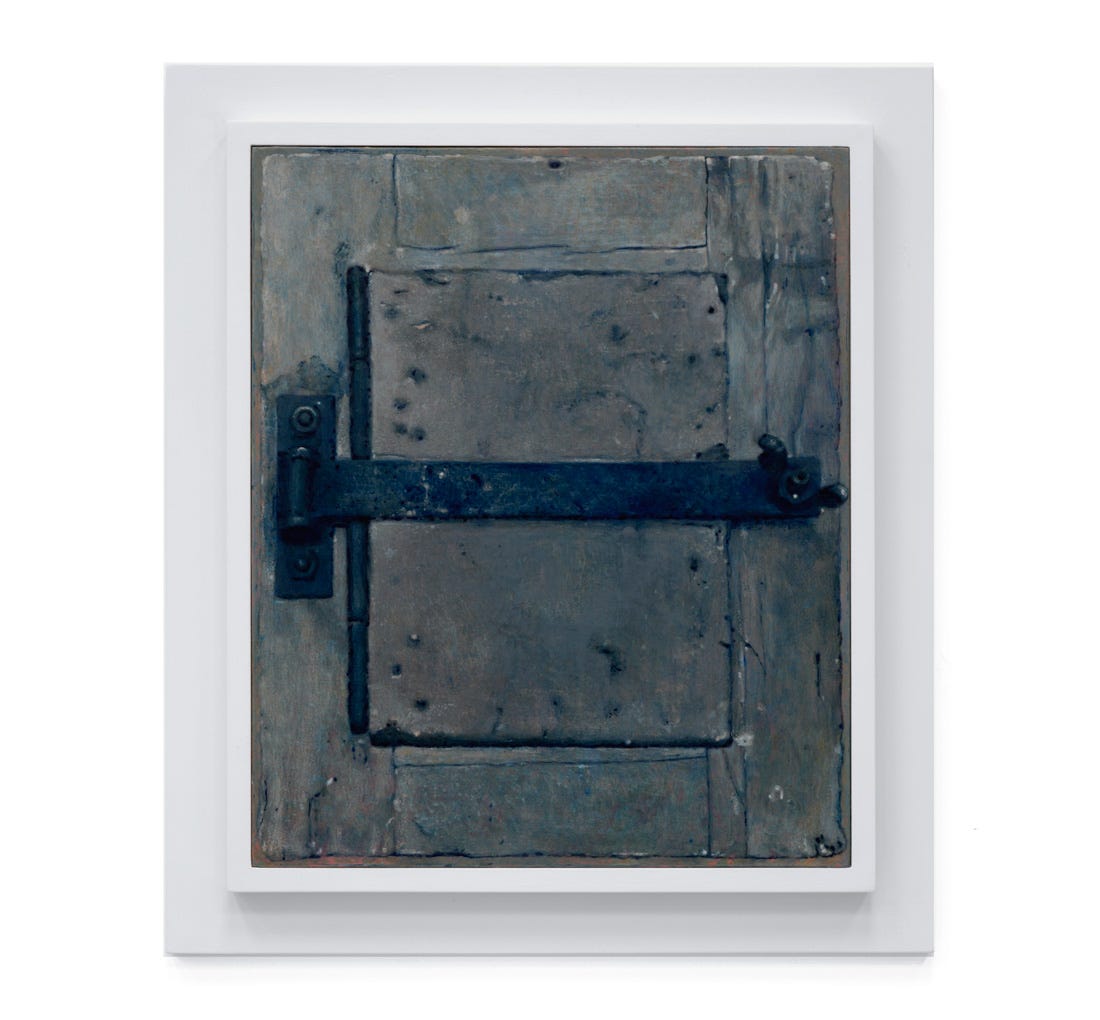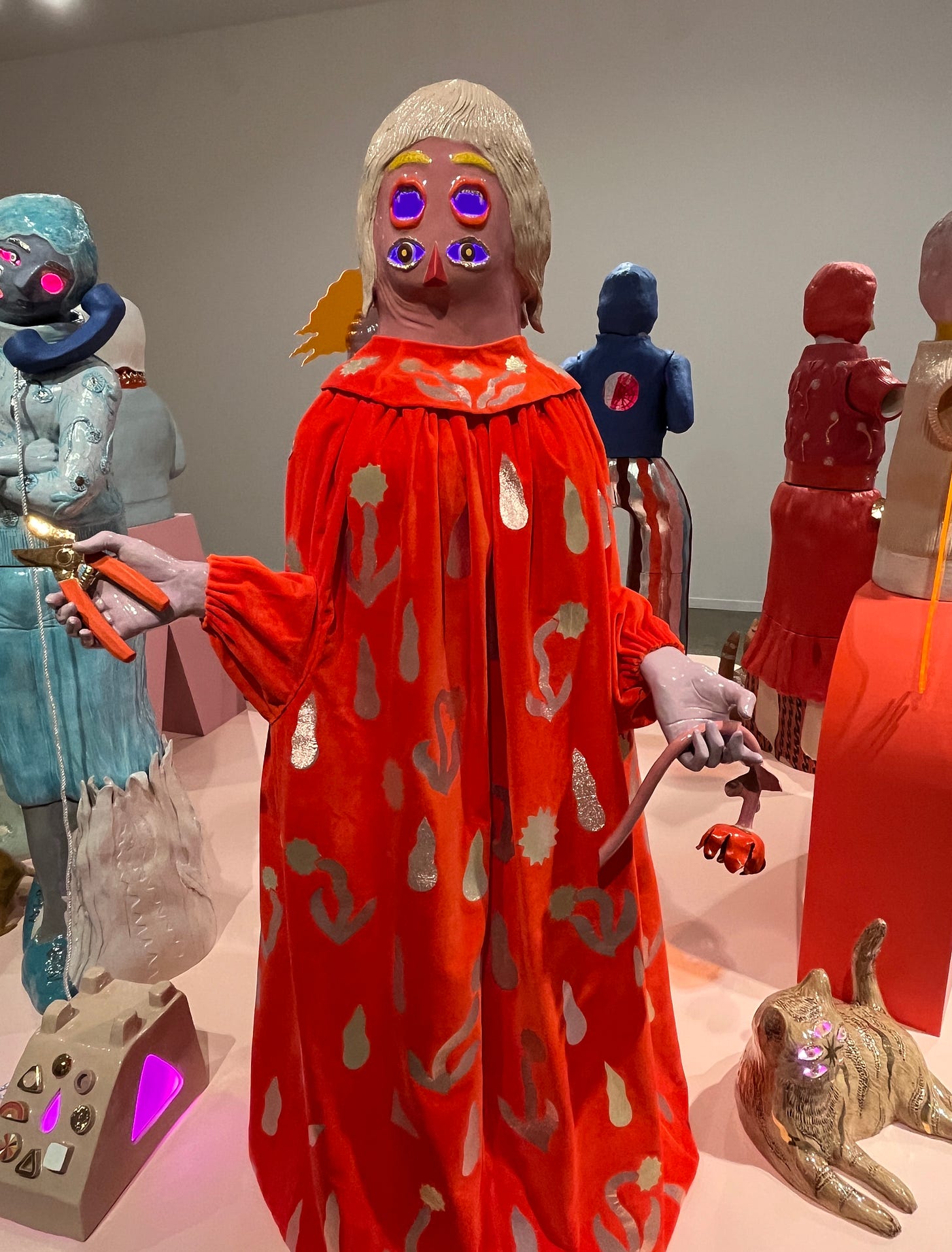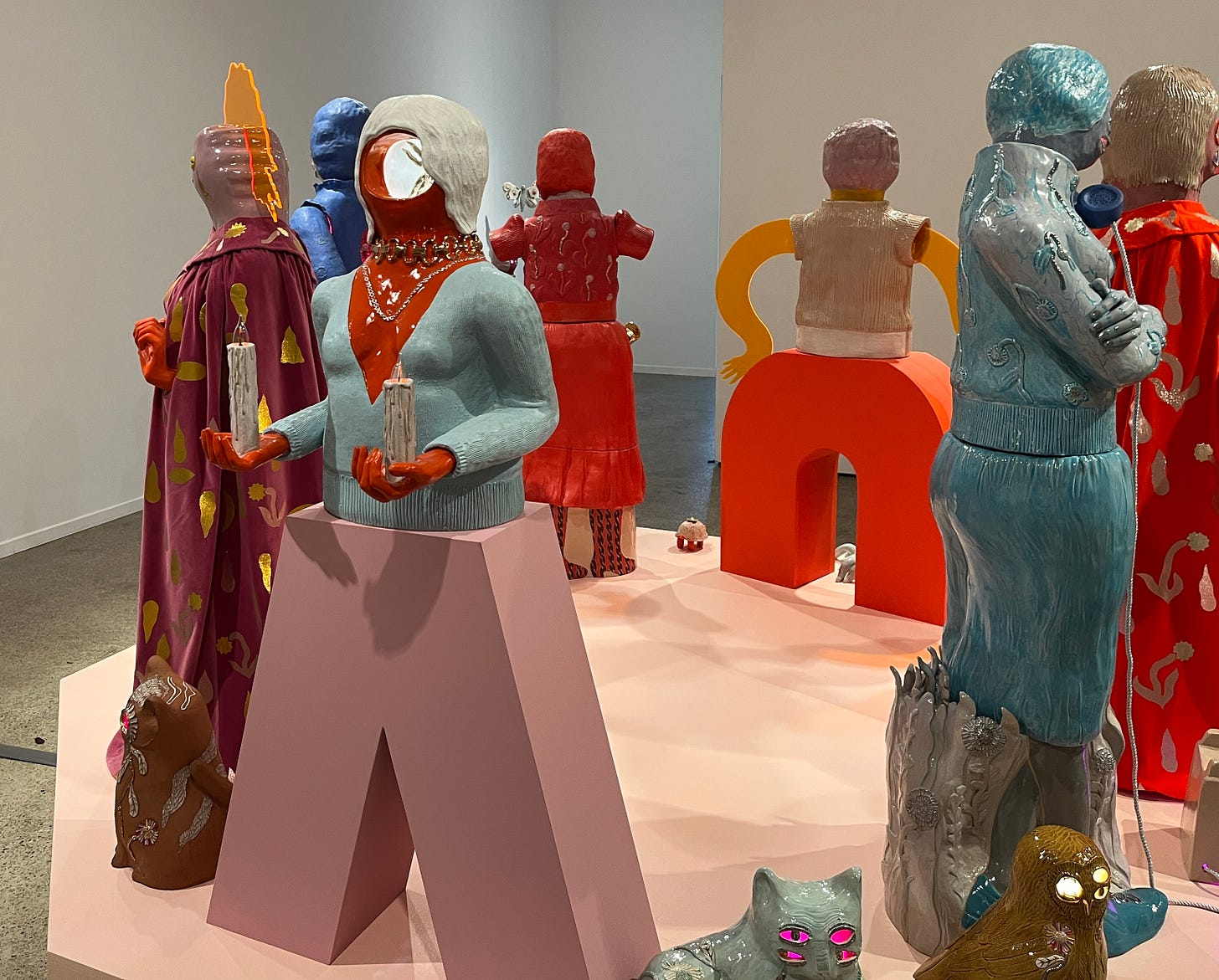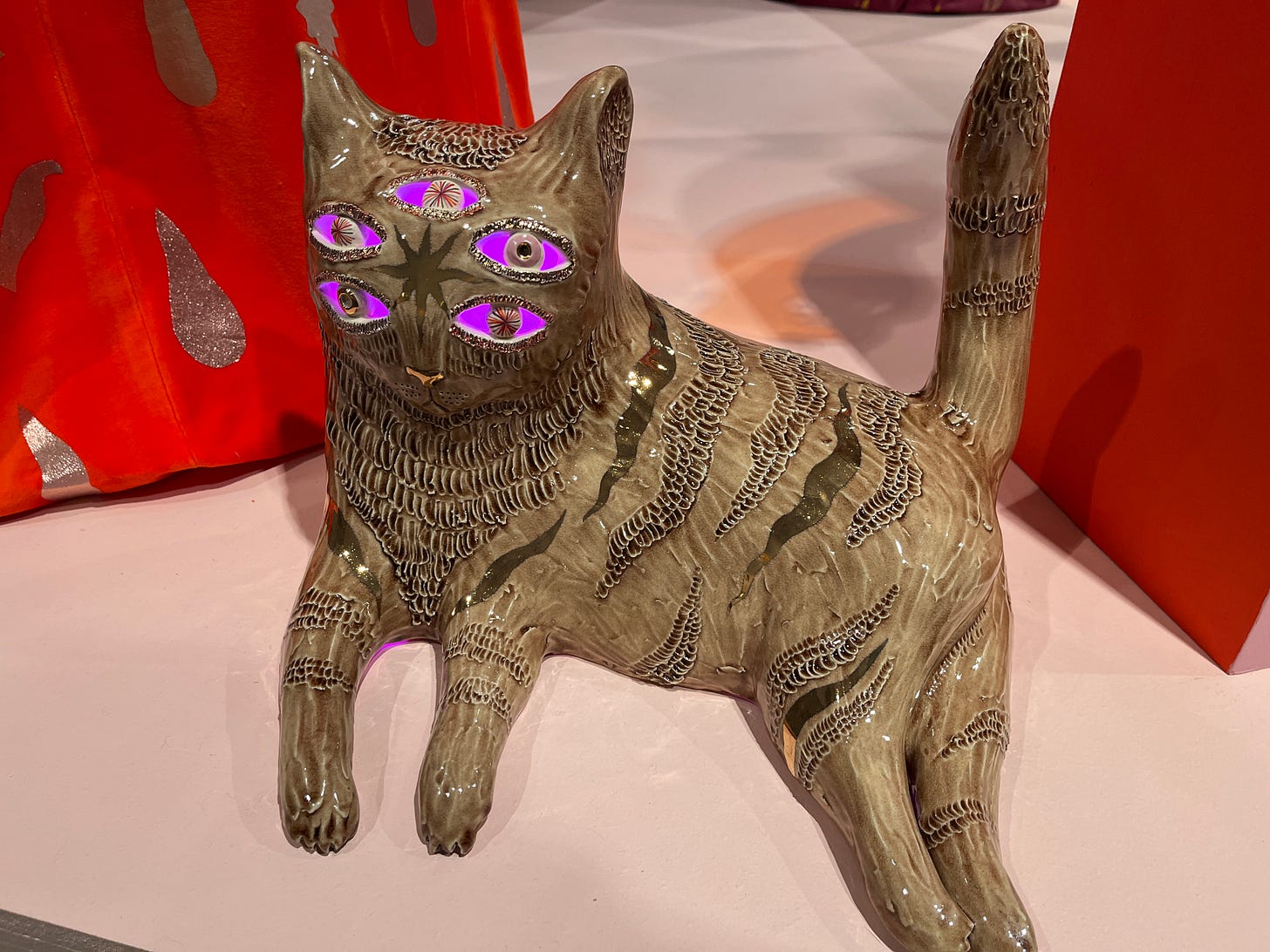I was going to do a deep dive on friend of Jeffery Epstein and current Museum of Modern Art trustee Leon Black this month, but the Emily Counts show at studio e in Seattle got extended to December 23, so I decided to talk about that instead. Never fear, I will write about Black in the next issue; I assume he’s still gonna be a creeper in a month. I did email MoMA to confirm he is still on the board but received no response. Hmm.
I saw three amazeballs (that’s a fancy art term) shows so far this year. One was Garabatos by Rodrigo Valenzuela at the Pacific Northwest College of Art as part of Converge 45, which is Portland’s big art biennial. You can read about the show here, see photos of this work on Instagram, and watch his artist talk here.
Also a part of Converge 45 is Yishai Jusidman’s Prussian Blue at the Oregon Jewish Museum and Center for Holocaust Education. It remains up for a few more days through November 26. You can read more here and see more here.
The third show is happening now in Seattle at studio e: Emily Counts So Familiar. The show was initially set to close at the end of November, so I wasn’t going to write about it because there wouldn’t be much time for folks to go see it, but since the end date has been moved out, I’m doing it. Here is the gallery site for the show. You can also see more pictures on Counts’ Insta.
As someone who has written and read A LOT of artist statements, I will tell you they are mostly crap. At their worst, they are a sludge of incomprehensible buzzwords (AKA International Art English,) and at their best, they get viewers curious to see the show. Counts’ is pretty good; there’s no art jargon, and it explains the impetus behind the work without trying to impose a theoretical framework on the show that isn’t really there. Normally, I wouldn’t post the whole statement in a review, but I think people can benefit from seeing one that doesn’t suck.
“A coven of life-sized, ceramic figures stand in ceremony in Emily Counts’ exhibition “So Familiar,” the artist’s third show with studio e gallery. Each figure is a composite portrait of women in the artist’s past and is paired with an animal familiar; a spiritual companion believed in folklore to protect and assist. In the front gallery space, owls, cats, spiders and moths each align with their kindred spirit. These pairs are steeped with symbols of their strength and energy, describing deeply personal beings while still allowing the viewer to interpret their own meanings and narratives through rearranged facial features, glowing interiors and raucous, velvet hues.
In the back of the gallery, the Great Grandmother Wizard Queen lies in repose surrounded by offerings of abundance and creative plenty. Larger than life and with an ever-spinning spider in her belly, she watches over the others and bestows ingenuity. By reconfiguring these figures and their accompanying objects from her previous installation “Sea of Vapors” at the Museum of Museums, Emily Counts creates new narratives for these figures as they move from space to space.”
I was not able to see the Sea of Vapors show at the now sadly defunct Museum of Museums (MoM), but here is a video:
So Familiar recontextualizes the almost life-size mixed-media-but-mostly-ceramic figures from the MoM show by placing them in an outward-facing circle and adding animal familiars into the mix. (I do get the double meaning of the title, but I hate puns and am refusing to engage with this one anymore.) While the female figures refer back to people in Counts' past, the names of the pieces don’t reveal specifics. There is the Gold Chain Matriarch and Vampire Florist. There is an Undressing Figure with Blue Cardigan and a Red Grandmother. The familiars rest on the floor, and while they seem to be paired with the larger figures, there doesn’t seem to be much interaction between the animals and people - mostly because they are on different planes. Because of their placement, the ceramic figures interact with the audience - not with each other. While one can step back and survey the whole tableau, I was drawn in to investigate each figure individually.
I am wholeheartedly won over by the physicality of these pieces. At first glance, they look as if they might be kinda twee. The figures are dressed in retro-looking sweaters and lush velvet mystical robes, but one look at their faces dispels any cutesy vibes. Features are rearranged into orderly grids of mouths and eyes and noses, or the face itself has been replaced by a video screen. There are vampire mouths where the eyes should be or there are extra eyes where the nonvampire mouth should be. Every surface is inviting, whether glossy, velvety, or deliciously matte. It’s hard not to want to touch everything, although considering the breakability of ceramics, to do so would invite disaster. (Don’t do it!)
The piece that works best for me is the installation in the back room, Great Grandmother Wizard Queen. It’s filled with other ceramic works, soft sculptures, and a reclining figure with a video screen in her abdomen showing a spider doing spider stuff. The pieces in the front room feel like they are visiting our world for a while, but we are in HER universe in the back. I’d like to see this show on a grander scale, where all the women get to interact with each other in a field of multi-colored strawberry softies and we are the visitors from afar. (But I can only evaluate the show that is and not the one in my headcanon, and this show is great! Go see it!)
I am currently rereading some of art critic Lucy Lippard’s earliest writings about feminism and women’s art in the 1970s, and I realized it was within my lifetime that female art students had few-to-no women artists to look at when developing their work. Women have always made art, but for a very long time, that work was mostly invisible. How would Counts’ work have been read 50 years ago? Twenty-some years ago, I worked with a computer engineer, Clark, who told me he didn’t like to work with women because they did too much of their work cooperatively. WTF dude? I also recently read in the New York Times that some of the work currently attributed to Hilma af Klint might actually have been done by other members of the spiritual art collective she belonged to, the Five. She is often portrayed as a lone figure inventing abstraction before dudes did, but she wasn’t by herself. She explored this world with four other women. I wonder about the women behind Count’s pieces. Were any of them artists? Did she know them all or were some of them influential, but long since dead?
I went back to Lippard for a project I am researching but found the essays resonated with me in a way I wasn’t expecting. I think we all thought the future would be better for women, and for some women it is. But for a lot of us, things haven’t changed that much, especially regarding reproductive health care. I think it is still kinda revolutionary for a woman to recognize and make art about other women, especially work that isn’t strictly autobiographical. (Also, just to be clear, I am not a gender essentialist. There are lots of different ways to be a woman, and trans women are women. The end. Thank you for coming to my TED talk.) I like thinking about the women portrayed in this show. Who are they? Where do they get their cool sweaters? Are the vampire mouths actually big enough to bite someone? What are they thinking? Are they friends with each other? How are their world domination plans going? What are their relationships with their familiars like? Are they witches, or do they just seem like witches to people who are afraid of their strength? I bet they have cake at their coven meetings. And yes, I am being silly, but there is something playful about this work that invites flights of fancy while at the same time being grounded in the substantiality of the clay figures.
Emily Counts So Familiar at studio e in Seattle through Dec 23.

